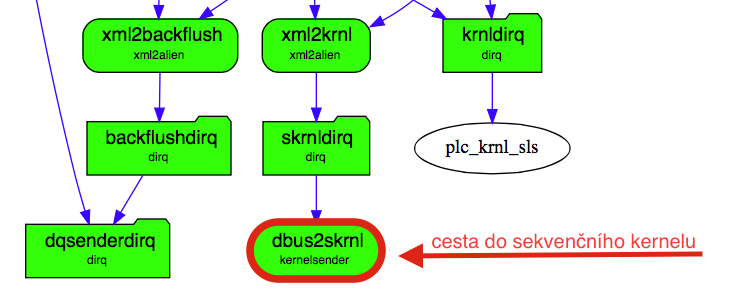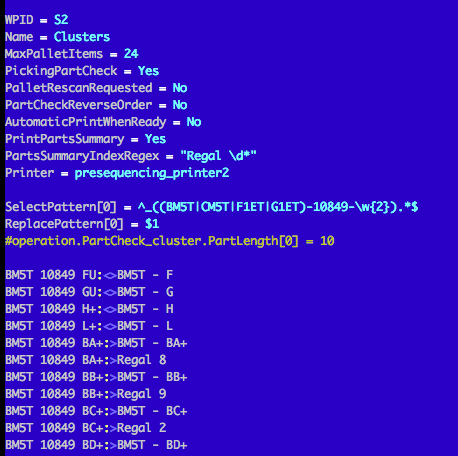How things work
From PlcWiki
(Created page with '== '''Introduction''' == Sequential picking is a method of preparing parts for the cockpit often at the moment when the production of the cockpit itself has not started on the…') |
|||
| Line 4: | Line 4: | ||
Sequential picking is a method of preparing parts for the cockpit often at the moment when the production of the cockpit itself has not started on the production line. In SAS, either sequential picking is used, which means preparing parts for pallets based on production data received into the kernel. Each pallet contains parts for multiple cockpits. The second method of preparation of parts is based on the so-called tablet kitting method, where boxes for specific cockpits are prepared and the application on the tablet is used for data. This article discusses sequential picking as implemented on SAS lines in Saarlouis, Boleslav and Wolfsburg, for example. | Sequential picking is a method of preparing parts for the cockpit often at the moment when the production of the cockpit itself has not started on the production line. In SAS, either sequential picking is used, which means preparing parts for pallets based on production data received into the kernel. Each pallet contains parts for multiple cockpits. The second method of preparation of parts is based on the so-called tablet kitting method, where boxes for specific cockpits are prepared and the application on the tablet is used for data. This article discusses sequential picking as implemented on SAS lines in Saarlouis, Boleslav and Wolfsburg, for example. | ||
| + | |||
| + | |||
| + | |||
| + | |||
| + | == '''Dataflow''' == | ||
| + | |||
| + | |||
| + | [[File:slsdataflow_small.png]] | ||
| + | |||
| + | |||
| + | Data received from the JIS (or other source) travels through the dataflow to the main kernel. There is a branch within the dataflow that belongs to the sequential kernel plc_skrnl. For the sake of clarity, the second instance of the kernel is used as the sequence picking kernel, but even the classic kernel contains sequence picking and can work in this mode. | ||
| + | |||
| + | |||
| + | == '''Kernel and its configuration''' == | ||
| + | |||
| + | |||
| + | The kernel receives data as it enters the system. He gradually prepares the parts in the sequence and places them in pallets. To what palette what part will be driven by the splan configuration file. | ||
| + | |||
| + | [[File:splan.png]] | ||
| + | |||
| + | Above is an example of such a configuration taken from the SAS SLS plant. | ||
| + | |||
| + | <xml> | ||
| + | WPID = S2 | ||
| + | Name = Clusters | ||
| + | MaxPalletItems = 24 | ||
| + | </xml> | ||
| + | |||
| + | These are basic information: pallet identifier and name. Number of parts per pallet. | ||
| + | |||
| + | <xml> | ||
| + | PickingPartCheck = Yes | ||
| + | </xml> | ||
| + | |||
| + | This is the parameter for ensuring that parts on the pallet are still scanned for inspection after they are assembled. When set to '' '' Yes' '', the pallet builder must take the scanner and scan all the parts sequentially. Just for proper assignment of scans to a specific palette, the configuration also includes SelectPattern and ReplacePattern, which takes the specific part from the scan to be compared. | ||
| + | SelectPattern '' 'must match the entire input' '', otherwise ReplacePattern will not work correctly. | ||
Revision as of 13:07, 3 April 2020
Introduction
Sequential picking is a method of preparing parts for the cockpit often at the moment when the production of the cockpit itself has not started on the production line. In SAS, either sequential picking is used, which means preparing parts for pallets based on production data received into the kernel. Each pallet contains parts for multiple cockpits. The second method of preparation of parts is based on the so-called tablet kitting method, where boxes for specific cockpits are prepared and the application on the tablet is used for data. This article discusses sequential picking as implemented on SAS lines in Saarlouis, Boleslav and Wolfsburg, for example.
Dataflow
Data received from the JIS (or other source) travels through the dataflow to the main kernel. There is a branch within the dataflow that belongs to the sequential kernel plc_skrnl. For the sake of clarity, the second instance of the kernel is used as the sequence picking kernel, but even the classic kernel contains sequence picking and can work in this mode.
Kernel and its configuration
The kernel receives data as it enters the system. He gradually prepares the parts in the sequence and places them in pallets. To what palette what part will be driven by the splan configuration file.
Above is an example of such a configuration taken from the SAS SLS plant.
WPID = S2 Name = Clusters MaxPalletItems = 24
These are basic information: pallet identifier and name. Number of parts per pallet.
PickingPartCheck = Yes
This is the parameter for ensuring that parts on the pallet are still scanned for inspection after they are assembled. When set to Yes' , the pallet builder must take the scanner and scan all the parts sequentially. Just for proper assignment of scans to a specific palette, the configuration also includes SelectPattern and ReplacePattern, which takes the specific part from the scan to be compared. SelectPattern 'must match the entire input' , otherwise ReplacePattern will not work correctly.


